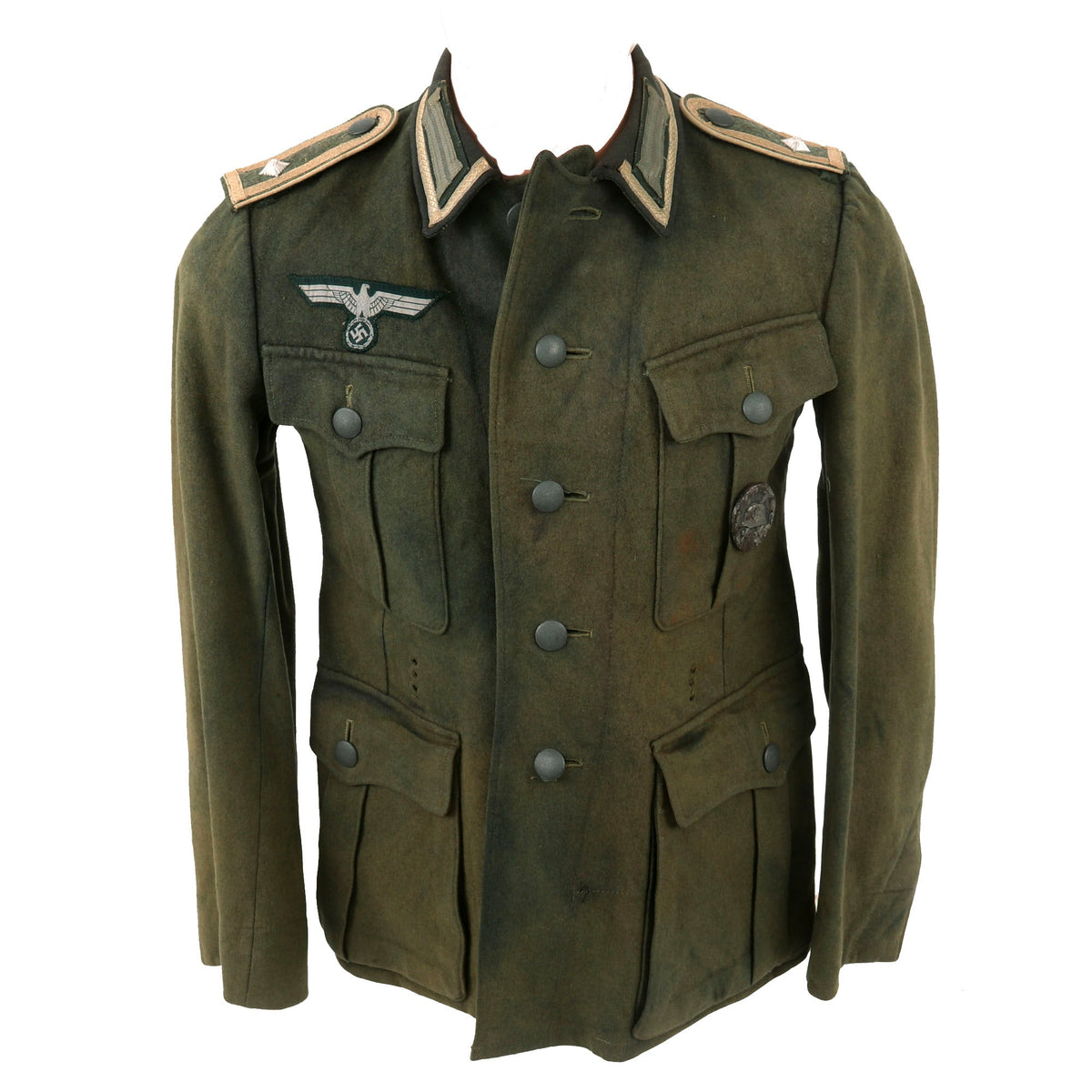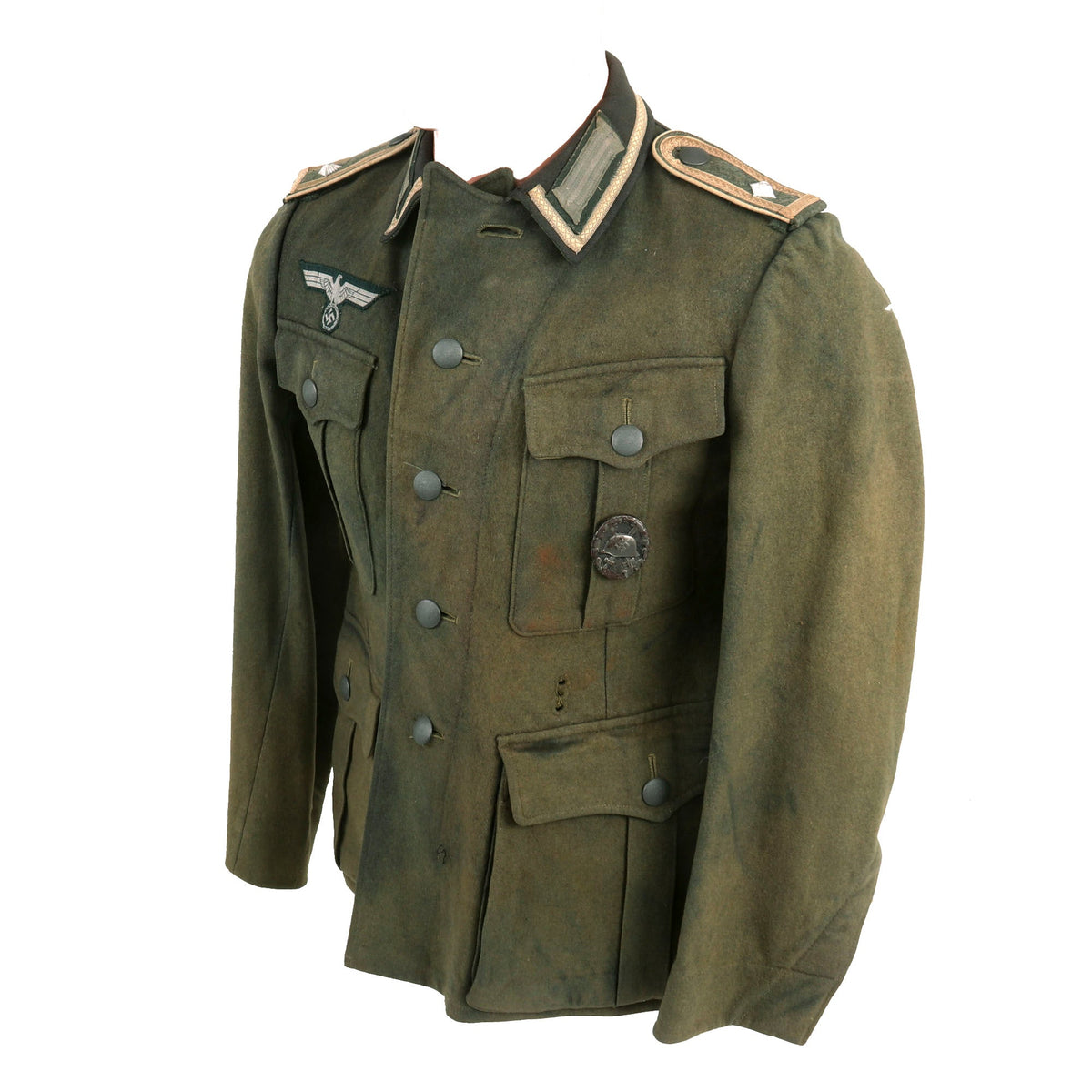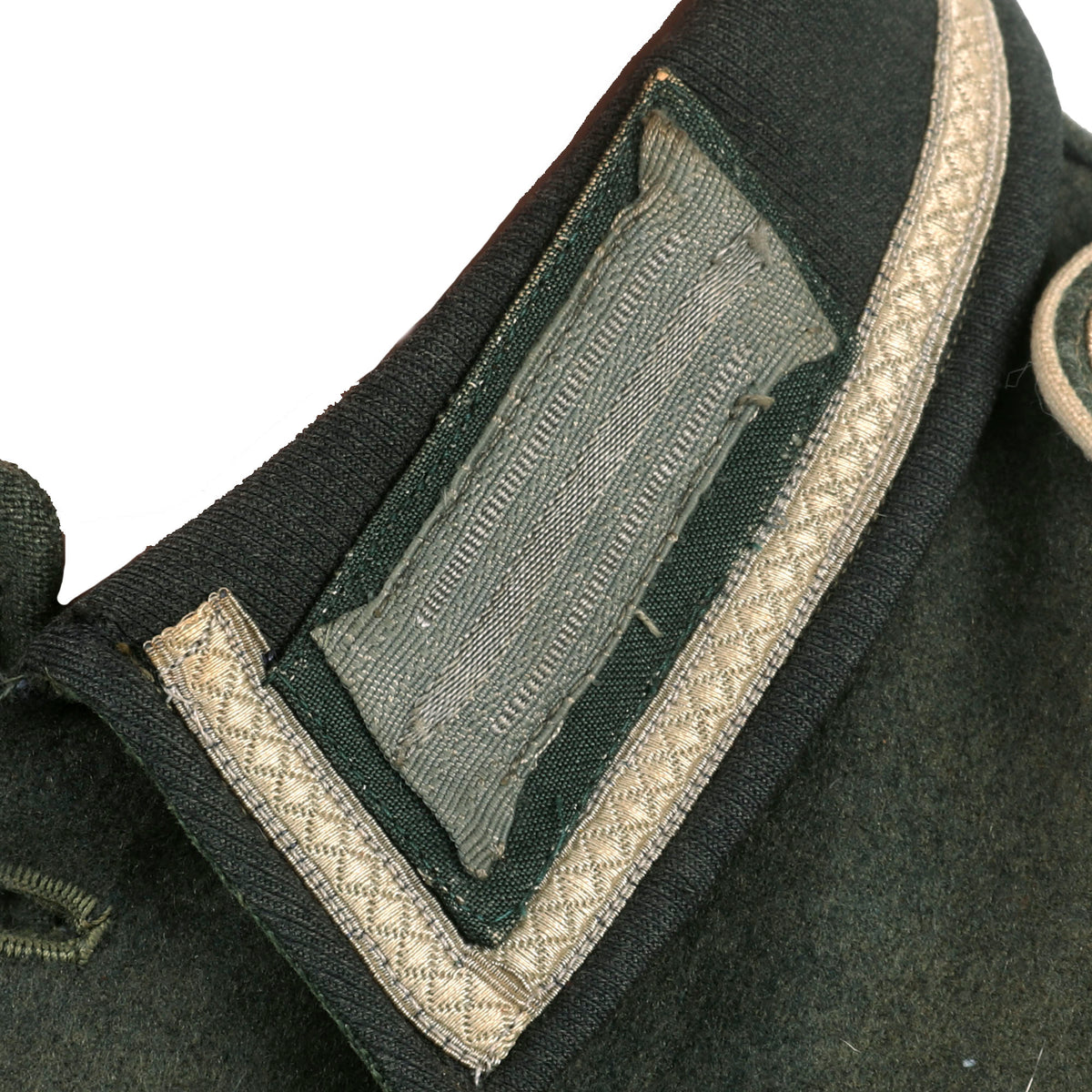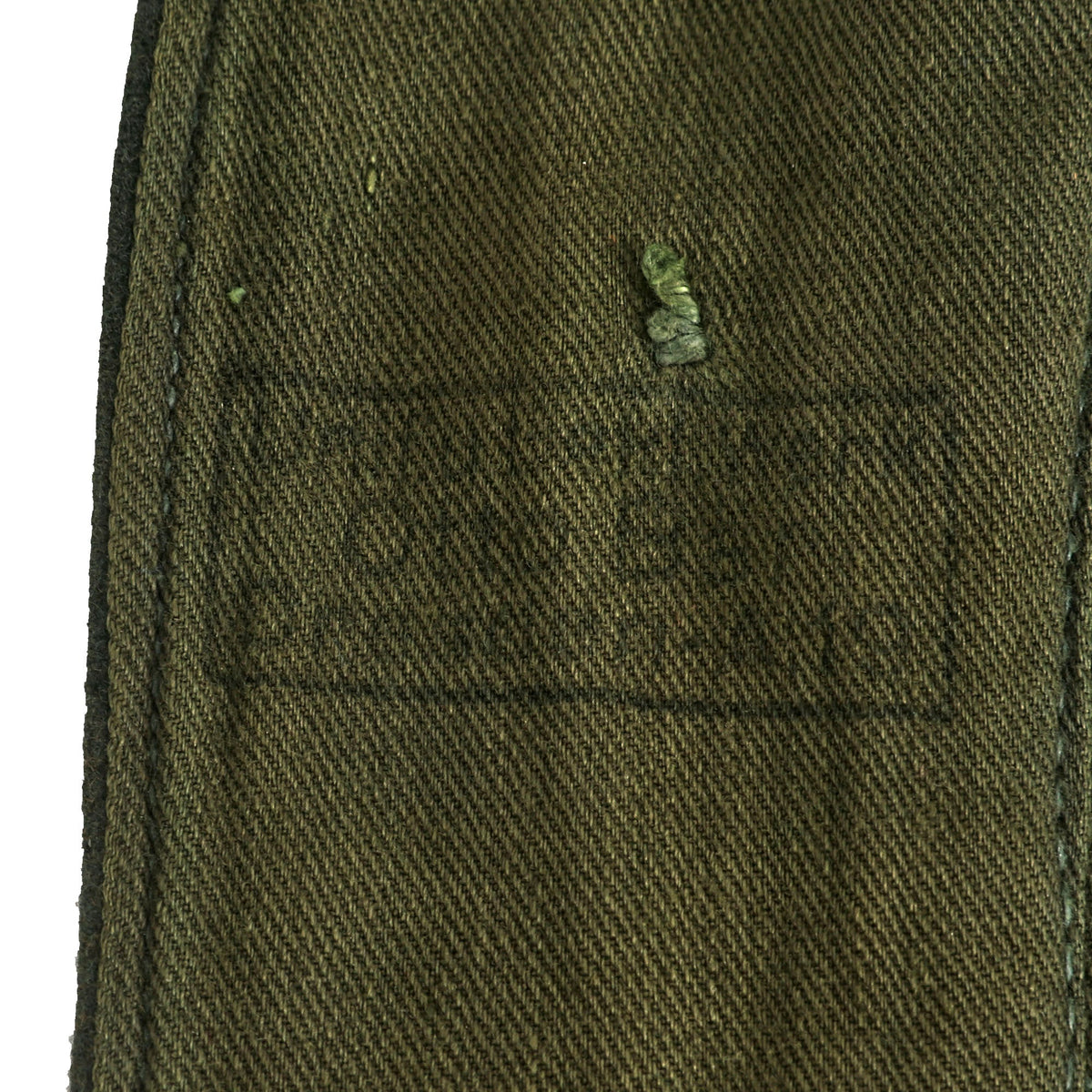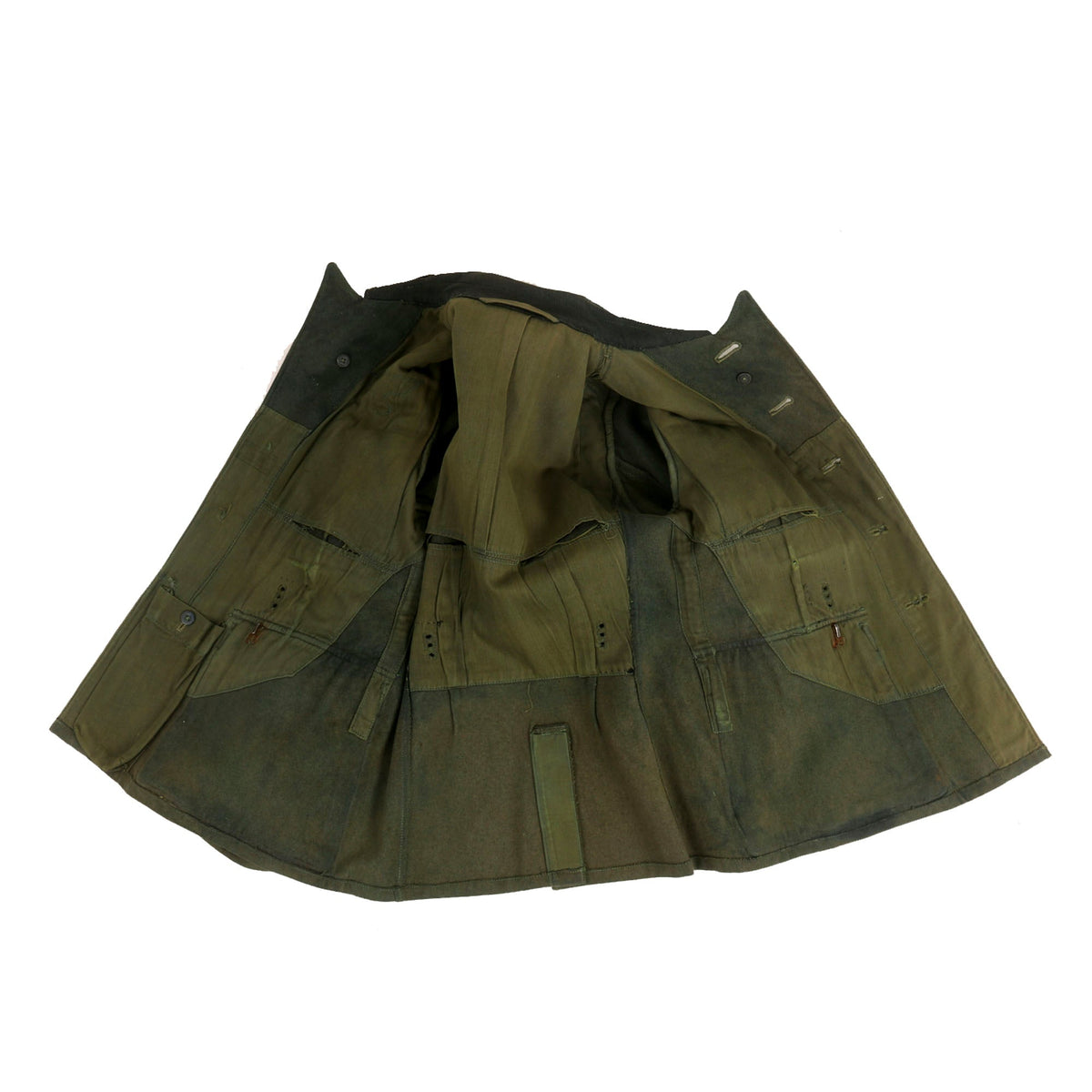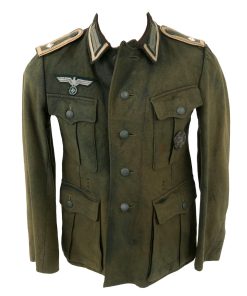Original German WWII Depot Refitted Heer Army Infantry Feldwebel NCO M36 Uniform Tunic – Replica Shoulder Boards Original Items
$ 1.095,00 $ 273,75
Original Item: Only One Available. This is a very nice early war pattern German WWII Heer Army Infantry Unteroffiziere mit Portepee (Senior NCO) M-36 Field Tunic, showing wear from service and a good amount of fading on the exterior. The tunic also looks to have been refitted / restored at arsenal during the war, where the collar and some other portions may have been repaired and/or replaced. This was especially common later in the war, as materials became scarce. There is no maker tag, but there is what looks to be a maker marking on the lining on the inside of the right side front closure:-
Unif u. Led. Werk
Otto Bär
Dresden-A,19
The tunic features four pockets with scalloped flaps and pebbled non-magnetic zinc alloy buttons, and is closed with five pebbled buttons on the right breast flap meeting an equal number of reinforced buttonholes on the left flap. All buttons sewn directly to the uniform, and are maker marked on the reverse, though this can be hard to see due to oxidation. They were most likely all original painted, but the paint has almost completely worn away. The interior of the tunic is lined with olive green canvas, which is fairly standard for quartermaster issued tunics.
It is adorned with the usual rank and branch insignia used on German tunics. The attractive Army breast eagle is the correct NCO BeVO embroidered type, with a green background and gray threading. It is machine sewn through to the inner lining, so it was probably replaced at some point. The collar looks to have been replaced at arsenal, and is gray on the exterior, with reinforced green underside. It is decorated a strip of 9mm flat silver-grey woven rayon braid (Unteroffoziers-Tressen), sewn around the collar border. There are EM/NCO litzen collar patches on each side, which are woven from gray and green threads, and are installed on green backgrounds. They do not have Corps Color stripes, as in 1938 they were removed from EM/NCO collar insignia to save time.
The button attached style NCO shoulder straps (Unteroffiziere Schulterklappen) attached to the tunic have been examined by experts, and they are post war replicas, possibly made from original materials. They are using the wrong color of tresse for wartime production, and are made in the later post 1940 style, with field gray wool construction. The tresse goes around the entire circumference, and they each have a single rank pip attached onto the shoulder boards, indicating the rank of Feldwebel, a senior NCO rank equivalent to a U.S. Army Technical Sergeant. The piping around the shoulder straps is Weiß (white), the Corps Color (Waffenfarbe) for Infanterie (Infantry) and Motorisiert Infanterie (Motorized Infantry).
There is a very nice service worn 3rd Class Wound Badge in black attached below the left pocket. Overall condition is very good, but it definitely does show wear from use in service. The wool fabric shows wear, fading, and staining to the exterior, and definitely looks to have seen long use during the war.
A very nice salty example of a German WWII Infantry NCO’s M36 Field tunic, ready to outfit with medals and display!
Approximate Measurements:
Collar to shoulder: 9″
Shoulder to sleeve: 23.5”
Shoulder to shoulder: 14”
Chest width: 17.5″
Waist width: 16.5″
Hip width: 17″
Front length: 26.5″
Field Tunic (Feldbluse) Model 1936
Terms such as M40 and M43 were never designated by the Wehrmacht, but are names given to the different versions of the Model 1936 field tunic by modern collectors, to discern between variations, as the M36 was steadily simplified and tweaked due to production time problems and combat experience.
When the NSDAP came to power in early 1933 the Reichswehr, the armed forces of the Weimar Republic, were near the end of a two-year project to redesign the Army Feldbluse (field-blouse). Beginning in that year the new tunic was issued to the Reichsheer and then the rapidly growing Wehrmacht Heer, although minor design changes continued to be made until the appearance of the standardized Heeres Dienstanzug Modell 1936. The M36 tunic still retained the traditional Imperial and Reichswehr uniform color of grey-green “field gray” (feldgrau) wool, but incorporated four front patch pockets with scalloped flaps and pleats (on Reichswehr tunics the lower pockets were internal and angled). The front was closed with five buttons rather than the previous eight, and the collar and shoulder straps were of a dark bottle-green instead of the Reichswehr grey. Compared to the Weimar-era uniforms the skirt of the feldbluse was shorter and the tailoring was more form-fitting due to Germany’s adoption of mechanized warfare: soldiers now spent much time in the confined space of a vehicle and a shorter jacket was less likely to pick up dirt from the seats. It also included an internal suspension system, whereby a soldier could hang an equipment belt on a series of hooks outside of the tunic. These hooks were connected to two straps inside the lining, which spread the weight of equipment without having to use external equipment suspenders. The M36 was produced and issued until the very end of the war, though successive patterns became predominant.
SS field uniforms were of similar appearance externally but to fit their larger patches had a wider, feldgrau collar, and the lower pockets were of an angled slash type similar to the black or grey SS service-dress. The second button of an SS Feldbluse was positioned somewhat lower, so that it could be worn open-collar with a necktie. Due to supply problems the SS were often issued army uniforms.
Fast Shipping with Professional Packaging
Thanks to our longstanding association with UPS FedEx DHL, and other major international carriers, we are able to provide a range of shipping options. Our warehouse staff is expertly trained and will wrap your products according to our exact and precise specifications. Prior to shipping, your goods will be thoroughly examined and securely secured. We ship to thousands clients each day across multiple countries. This shows how we're dedicated to be the largest retailer on the internet. Warehouses and distribution centres can be located throughout Europe as well as the USA.
Note: Orders with more than one item will be assigned a processing date depending on the item.
Before shipping before shipping, we'll conduct a thorough inspection of the items you have ordered. Today, the majority of orders will be delivered within 48 hours. The delivery time will be between 3-7 days.
Returns
The stock is dynamic and we cannot completely manage it because multiple stakeholders are involved, including our factory and warehouse. So the actual stock may alter at any time. It's possible that you may not receive your order once the order has been made.
Our policy is valid for a period of 30 days. If you don't receive the product within 30 days, we are not able to issue a refund or an exchange.
You can only return an item if it is unused and in the same state as the day you received it. You must have the item in its original packaging.
Related products
Uncategorized
Uncategorized
Uncategorized
Uncategorized
Uncategorized
Uncategorized
Uncategorized
Armoured Fighting Vehicles of the World: AFVs of World War One (Hardcover Book) New Made Items
Uncategorized
Australian WWII Owen MK1 Machine Carbine SMG Custom Fabricated Replica with Sling Original Items
Uncategorized
Uncategorized
Uncategorized
Uncategorized
Uncategorized
Uncategorized
Uncategorized
Uncategorized
Uncategorized
Angolan Rebel 1970s era 60mm Inert Display Mortar from Angolan Civil War Original Items
